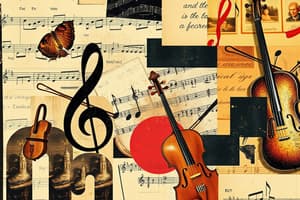Podcast
Questions and Answers
The preclassical style and eventual classical style developed as a reaction to what?
The preclassical style and eventual classical style developed as a reaction to what?
The complexity of baroque works
Select all the statements that describe mood in classical-era music, particularly in contrast to baroque music.
Select all the statements that describe mood in classical-era music, particularly in contrast to baroque music.
- Baroque music is primarily carefree.
- Classical music is consistently dramatic throughout.
- A classical movement can have contrasts within a theme. (correct)
- Classical music fluctuated between dramatic and carefree moods. (correct)
Which statement best describes the use of texture in classical compositions?
Which statement best describes the use of texture in classical compositions?
Classical pieces fluctuate between different textures.
What use of rhythm in classical music differs from baroque music?
What use of rhythm in classical music differs from baroque music?
How are classical melodies typically structured?
How are classical melodies typically structured?
Select all the composers of the classical era.
Select all the composers of the classical era.
What was one of the ways in which composers of the classical era achieved more expression in their music?
What was one of the ways in which composers of the classical era achieved more expression in their music?
Select all the statements that illustrate how classical composers created expression of mood in their music.
Select all the statements that illustrate how classical composers created expression of mood in their music.
Select all the ways the texture of music of the classical period differ from that of the baroque period.
Select all the ways the texture of music of the classical period differ from that of the baroque period.
Select all the characteristics of rhythm in music of the classical era.
Select all the characteristics of rhythm in music of the classical era.
Why did the basso continuo become obsolete in the classical era?
Why did the basso continuo become obsolete in the classical era?
Select all the general characteristics of melody in the music of the classical era.
Select all the general characteristics of melody in the music of the classical era.
How was the use of dynamics in the classical period different from the use of dynamics in the baroque period?
How was the use of dynamics in the classical period different from the use of dynamics in the baroque period?
Which of the following best describes the use of mood in classical music?
Which of the following best describes the use of mood in classical music?
Select all the descriptions that apply to the orchestra of the classical period.
Select all the descriptions that apply to the orchestra of the classical period.
Late baroque music was characterized by a ______ texture, whereas classical music is basically ______ in texture.
Late baroque music was characterized by a ______ texture, whereas classical music is basically ______ in texture.
What development led to the decline of the basso continuo in the classical period?
What development led to the decline of the basso continuo in the classical period?
Which instrumental family has the melody in the classical orchestra?
Which instrumental family has the melody in the classical orchestra?
Which best describes the balance and symmetry in a typical melody of the classical era having the form a a'?
Which best describes the balance and symmetry in a typical melody of the classical era having the form a a'?
Select all the typical practices for composers of the classic era.
Select all the typical practices for composers of the classic era.
Select all the groups of instruments that were standard in the orchestras of Haydn and Mozart.
Select all the groups of instruments that were standard in the orchestras of Haydn and Mozart.
Select all the reasons public concerts were so important for the middle class in the classical period.
Select all the reasons public concerts were so important for the middle class in the classical period.
Select all the composers who worked in Vienna during the classical period.
Select all the composers who worked in Vienna during the classical period.
Flashcards are hidden until you start studying
Study Notes
Preclassical and Classical Styles
- Classical style emerged as a response to the complexity found in baroque music.
Mood in Classical Music
- Classical compositions feature mood fluctuations, contrasting between dramatic and carefree themes.
- A single classical movement may encapsulate contrasts within its theme.
Texture in Classical Compositions
- Pieces exhibit variability in texture; they shift between different textural qualities.
- Classical music is primarily homophonic, contrasting with the baroque's polyphonic texture.
Rhythm in Classical Music
- Classical music employs a diverse array of rhythmic patterns, unlike baroque's limited patterns.
- Characteristics include rhythmic changes within movements and unexpected syncopations.
Melody in the Classical Era
- Melodies are typically tuneful, memorable, and often draw from folk or popular styles.
- Common structure consists of two equal-length phrases.
Composers of the Classical Era
- Notable composers include Haydn, Beethoven, and Mozart.
- Composers enhanced expression using techniques like crescendo and decrescendo.
Emotional Range and Control in Music
- Classical composers emphasized balance and logic while providing a wide emotional range.
- Mood changes are controlled, regardless of their abruptness or extremity.
Dynamics in Classical Music
- Dynamics in this era introduced gradual changes, contrasting with the more static baroque period.
Instruments of the Classical Orchestra
- The orchestra included strings, winds, brass, and percussion, with the clarinet gaining prominence.
- Strings typically carried the melody in orchestral compositions.
Characteristics of Compositions
- Typical practices involved contrasting themes, utilizing multiple themes within movements, and dramatic pauses.
Importance of Public Concerts
- Public concerts became vital for the middle class, providing access to music not available in court performances.
- Audiences sought the latest music, similar to nobles, making concerts a popular social gathering.
Innovations and Declines
- The basso continuo became obsolete due to a desire for more compositional control among classical composers.
- An increase in compositions aimed at amateur musicians contributed to the decline of the basso continuo.
Vienna during the Classical Period
- Haydn, Beethoven, and Mozart were prominent composers who worked in Vienna, significantly influencing the era's music.
Studying That Suits You
Use AI to generate personalized quizzes and flashcards to suit your learning preferences.




